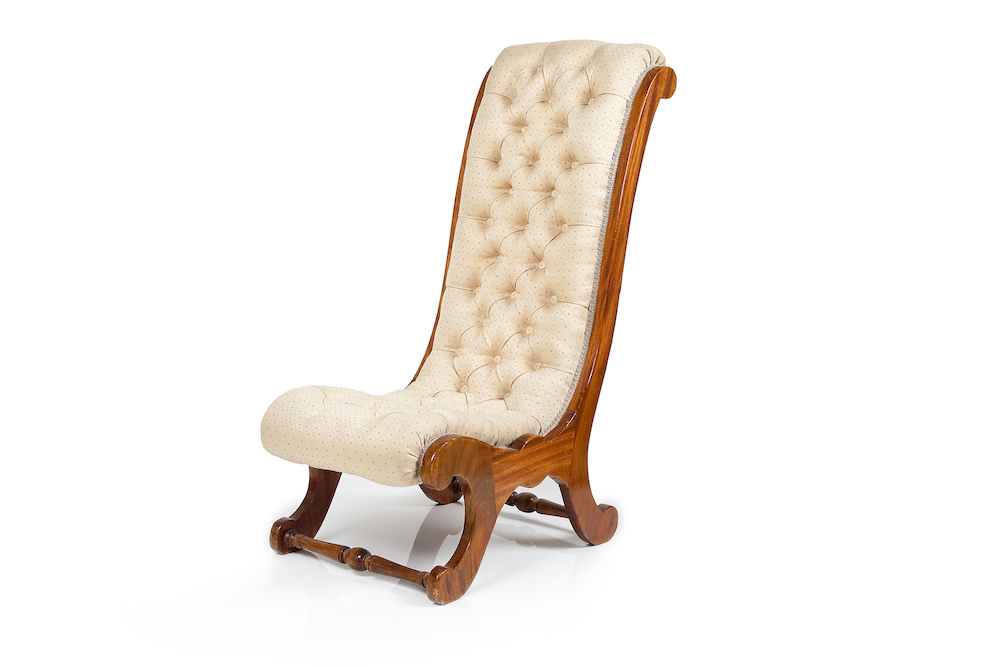
Deep Buttoning: A Timeless Tale of Elegance Through the Eras
A recent spate of deep-buttoned ottoman orders has prompted me to investigate the origins of this iconic upholstery technique. So join me in a journey through time as we explore deep buttoning evolution across historical periods.
Georgian Period (1714-1837): Elegance and Craftsmanship
The Georgian Period, spanning from 1714 to 1837 and divided into early (1714–1760), middle (1760–1780), and late (1780–1837), is renowned for neoclassical influences, symmetrical designs, and a strong emphasis on craftsmanship and refinement.
During this period, the era of elegance and craftsmanship, deep buttoning emerged not only as a decorative feature but as a functional necessity. While the exact origins of deep buttoning may be challenging to pinpoint definitively, it is thought it originated as a method to secure tufting in place to keep in place the internal horse hair stuffing. Legend has it that deep buttoning found a notable champion in Lord Phillip Stanhope, the 4th Earl of Chesterfield. It is believed that Lord Stanhope's commissioned the original Chesterfield sofa aiming to provide guests with extra seating that was subtly discouraging so they wouldn’t stay long! (seating was in those days unsprung and tough leather buttons made it even more uncomfortable). It inadvertently sparked a design revolution.
Regency (1811-1820): Timeless Sophistication
Our journey continues into the elegant Regency era of 1811 to 1820, known for its refined sophistication and impeccable craftsmanship. Regency footstools epitomized timeless elegance with clean lines, symmetrical proportions, and opulent fabrics like satin, damask, and plush velvet. Techniques like diamond tufting and grid tufting showcased meticulous attention to detail, setting the standard for classic design.
While deep-set buttoning as we know it today became predominantly popular in Victorian furniture, it subtly graced Regency pieces, adding a touch of luxury and sophistication. Typically crafted from high-quality materials like mahogany or rosewood, Regency furniture featured buttons covered in matching upholstery fabric or contrasting materials like brass or ivory.
Deep buttoning adorned a range of Regency furniture, including sofas, chairs, ottomans, and even headboards. Although more common in Victorian design, it certainly was a popular choice for those seeking to infuse their homes with luxury and elegance during the Regency era.
Victorian (1837-1901): Ornate Opulence
Next, we transition to the Victorian era, a golden age of opulence and extravagance that stretched from 1837 to 1901. Victorian footstools dazzled with ornate elegance, showcasing intricate patterns of much deeper-set buttons than the earlier periods and used luxurious materials like rich velvet, silk, and brocade. Hand-tufting techniques were employed by skilled artisans to create elaborate button designs, adding a touch of grandeur to furniture pieces and defining the era's affluent aesthetic. This is when deep-buttoning came into their own and after sprung upholstery had been introduced in the form of stitched-in coil springs in around 1828, deep-buttoned furniture was able to offer considerably more comfort.

Victorian Slipper chair reupholstered by The Bespoke Chair Company

Victorian Chaise Lounge reupholstered by The Bespoke Chair Company
Edwardian (1901-1910): Refined Simplicity
Our historical exploration continues into the Edwardian era, spanning from 1901 to 1910, a period characterized by refined simplicity and understated beauty. Edwardian footstools embraced a lighter and more delicate aesthetic, featuring softer curves, subtle button detailing, and materials such as linen, cotton, and leather. The craftsmanship of this era focused on achieving a harmonious balance between elegance and subtlety, reflecting a shift towards a modern interpretation of deep buttoning design.
And, we have arrived in the 20th century where the classic techniques and buttoning diamond patterns remained much the same as the Victorian times, with formal patterns, sometimes just as busy as in the Chesterfield style furniture of the mid-18th century. Materials, however, expanded to incorporate modern stuffings such as polyurethane foam.
In the 21st century, there has been a shift in design trends towards a preference for bigger diamonds in deep buttoned upholstery. Contemporary designers have also embraced larger buttons and unusual tufted patterns, resulting in a more modern and visually impactful look. This updated approach to deep buttoning combines the traditional craftsmanship with a fresh and innovative design aesthetic to cater to the evolving tastes of consumers in the modern era.
So, footstool enthusiasts, let us raise a toast to the artistry and craftsmanship that have stood the test of time, and may deep-buttoned footstools continue to enchant and inspire!
A Modern Take on Traditional Style Deep Buttoned Footstools all by The Bespoke Footstool Company




